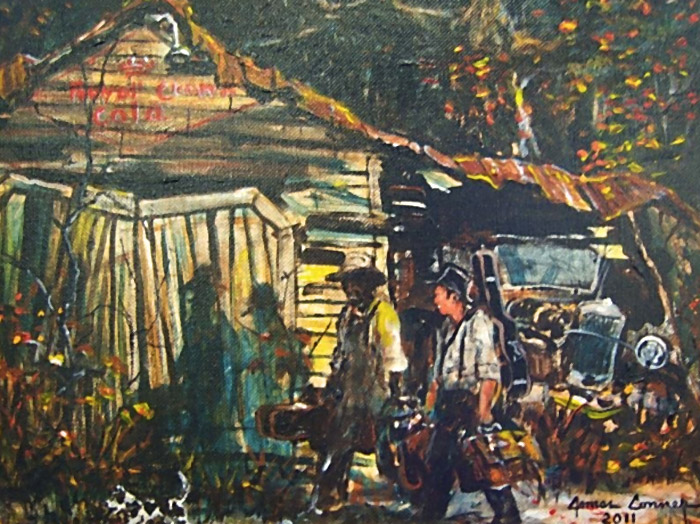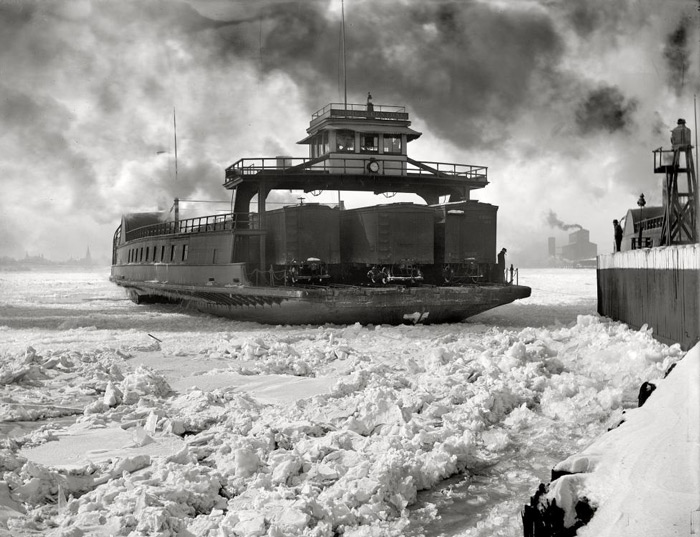Hole in the Clouds
Nov 8, 2009

Since the 1950s, the city of Detroit has lost half its population, which now stands at about 900,000. Entire inner-city neighborhoods have been abandoned, often burned out, and eventually bulldozed; Google Earth shows the downtown ringed by hundreds of blocks of grass and trees.
The blight has spread now to neighborhoods far from the city center. First one family, then another, leaves town in hope of finding work. They cannot sell their homes, but they leave anyway. Soon, their neighbors are leaving also, because semi-abandoned neighborhoods are dangerous and unpleasant places to live. Here is a picture from last summer of a Detroit neighborhood with just a few homes still occupied. By next summer, there will be fewer still.
streetscape
Detroit
Michigan
Aug 9, 2011
 In 1910, most of the excavation work for the new Michigan Central railroad station in Detroit was still being done with the loathesome short-handled shovels. In the background of this photo, however, we can glimpse the excavators of the future: smoke-belching job-killers, aka steam shovels.
In 1910, most of the excavation work for the new Michigan Central railroad station in Detroit was still being done with the loathesome short-handled shovels. In the background of this photo, however, we can glimpse the excavators of the future: smoke-belching job-killers, aka steam shovels.
The men are wearing hats, but not hard hats.
The Michigan Central Station survives today, I'm told, "if just barely." Short-handled shovels, too, are still around, in real life but more spectacularly in the blues.
cityscape
Detroit
Michigan
work
Michigan Central Station
1910
(Image credit: Detroit Publishing Company via Shorpy)
Dec 5, 2012
 Music Pals For a Lifetime, by James Conner.
Music Pals For a Lifetime, by James Conner.
Conner grew up in rural Noxubee County, Mississippi, where he learned to draw from correspondence lessons off the back of a matchbook. He left Mississippi after high school, first for Vietnam and then for about twenty years in Detroit, where he worked as a police sketch artist. But the downward spiral of layoffs that was crushing Detroit eventually reached into the police force and claimed Conner's job.
He was devasted, he said, until he realized that losing his job meant he could finally go home. He'd been homesick his whole adult life, missing Mississippi.
He was no longer young by the time he got back home, but he married and started a family and went back to school, studying art at the University of Mississippi. He taught art for a while, then took the plunge and became a fulltime painter. He said he was trying to become the black Grandma Moses.
Like Grandma Moses, he is drawn to images from his rural childhood. He seems homesick still for his southern roots. But unlike Grandma Moses, Conner is a trained artist with a twenty-first-century eye, and he is a black artist, with a complicated relationship to southern experience.
In this painting and many others, young men carrying guitar cases venture out into the world. In some of the paintings, they travel, perform, try to make something of themselves. In some, they are headed back home again, for whatever reasons. In at least one of Conner's works, the man with the guitar is stuck in the crossroads. I like this picture; the guys with guitars have places to go, dreams to work out, and probably hard times ahead, but at least they've got each other.
Tuscaloosa
Alabama
Detroit
Mississippi
James Conner
Noxubee County
Mar 17, 2017
 The ferry boat Michigan Central, carrying railroad cars, prepares to enter its slip on the Detroit River, circa 1900.
The ferry boat Michigan Central, carrying railroad cars, prepares to enter its slip on the Detroit River, circa 1900.
Detroit
winter
ice
ship
1900
ferry
(Image credit: Detroit Publishing Co via Shorpy)


 Music Pals For a Lifetime, by James Conner.
Music Pals For a Lifetime, by James Conner.